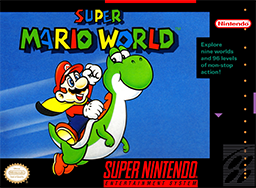426th played so far
Genre: Platform
Platform: SNES
Year of Release: 1991
Developer: Nintendo
Publisher: Nintendo
This game feels like one of those games everyone has heard of – as a SNES launch title, nearly everyone probably played it and has good memories of it.
The sequel to Super Mario Bros. 3 – I understand it was subtitled Super Mario Bros. 4 in Japan – expands on some of that game’s concepts while showing what the SNES could do better.
Our Thoughts
I first played this game at a friend’s, possibly the first SNES game I ever played. It’s hard to remember how I felt, but the progression of enthusiasm really follows the slow ramp up as ideas get introduced. My view is and was probably influenced by the (to me) still brilliant Super Mario Bros. 3, with this game building on it and honing it to perfection. It’s more colourful, more fluid, it looks and sounds better (almost all the music, apparently, being based on one melody, modified to fit the area) and it plays as good. In part, probably, because the game plays so much like its predecessor. A lot of features were added – and we’ll get to those – but the physics, the gameplay, everything feels as tight as before, making it instantly familiar and giving some early wins.
That’s not to say the game is only accessible to those who played the previous game, but it shows how competently the game builds on its previous iterations.
Taken on its own, the game feels just as accessible. One of the best planned things in Mario games, especially its platformers, is the pace at which new elements are introduced, even with the branching map. Yoshi’s House gives you a chance to practice the basics, after which one level ‘explains’ the cape, pipes and gives some jumping experience, while the other gives full attention to the new big addition to the Mario family, Yoshi, before going on to ‘teach’ jumping levels, switch palaces, water and castles. The second world continues it, but the first is the one that really feels like it’s covering the basics.
Yoshi is probably the game’s more notable addition, even if in many levels he shines by his absence. Indoor areas generally don’t allow him in (he returns afterwards) while it seems like finding him in normal levels is prety rare too. At the same time, as he carries over between levels, having to backtrack to get him to find a secret exit is just another challenge.
While your main goal in the game is still to beat Bowser, the implied secondary goal of beating all levels is there too. The game pushes that even further, by including secret exists in a number of levels. You are told when loading the game how many you have found – the bigger challenge of this game, more difficult than just getting to the official end of the game.
The excellent level design, including the star levels and hidden worlds that are optional but require every bit of skill you have, are just one part of makes the game great. The game has great graphical design as well, with colourful designs throught out the levels, making far more use of the SNES’s capabilities and feeling crispier than the series’ NES roots.
Final Thoughts
It feels rare to find a game that works so well on its own merits and adds enough to a series to be a great game at its own right, while at the same time feeling like such a good sequel that organically adds a few things to an already great game. It seems to work on every level.
It’s debatable whether this or Super Mario Bros. 3 is the better game, but in a way it doesn’t matter – they both have their qualities and, in some way, seem so linked they rely on each other’s work too much to say.
